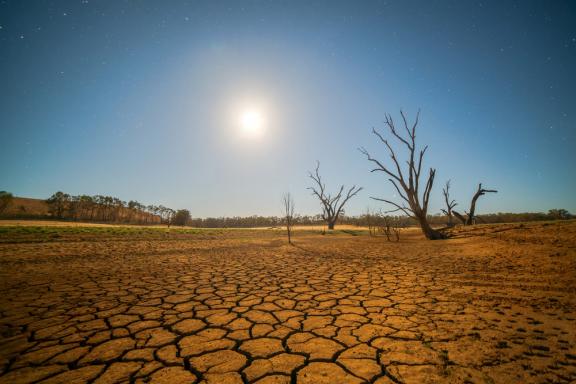In a race against time: Machine learning for the climate emergency
Faster, faster, faster! Clock is ticking.
With the urgent need to achieve zero-net greenhouse gas emissions by 2050, climate practitioners are in a race against time. As UN Secretary-General Antonio Guterres emphasized time and time again, if we fail to meet this target, the damage the climate crisis would bring to economies, societies, and people would be beyond measure and far greater than the disruption caused by COVID-19. Against this backdrop, climate change interventions are leveraging methods to work more efficiently and effectively. Notably, the emerging state-of-the-art innovations using machine learning techniques continue to captivate multi-sectoral disciplines to leverage their capabilities (Jordan & Mitchell, 2015).
What is machine learning?
Machine learning (ML) refers to the use of algorithms to learn from data without being explicitly programmed. These algorithms are broadly categorized into:
- Supervised learning; the user teaches the algorithm how to learn by providing example data and corresponding target responses.
- Unsupervised learning; the algorithm learns by itself from example data without any corresponding data responses.
- Reinforced learning; the algorithm learns by reacting to its own environment (Judith & Kirsch).
Such learning algorithms have been successfully deployed in applications for text mining, image recognition, information extraction, speech processing, quasi-experiment optimization, and many more (Mohri, Rostamizadeh, & Talwalkar, 2018). Machine learning enriches traditional statistical modeling with its ability to model complex, large-scale, and fundamentally uncertain problems, such as climate change (Rolnick, et al., 2019). As we know, the ongoing fourth industrial revolution is enabling the availability of massive data from digital technologies. This kind of data, commonly characterized as "big data," is computationally expensive to model with traditional statistical methods, due to its volume, velocity, and variety (Ibid. 37).
How can machine learning be useful in climate action and assessment?
In the climate space, Dlamini (2016) and Aguilar-Amuchastegui, Riveros, & Forrest (2014) used these techniques to assess climate-induced vulnerability by analyzing deforestation patterns to inform early warning systems. Similarly, Jakariya, et al. (2020) developed a tool for assessing agricultural vulnerability enabled by machine learning. Furthermore, a team at the International Fund for Agriculture Development used text mining to extract insights that were used to visualize the impacts and trends of their funded climate change interventions. One of their visualizations included a time trend graph of the presence of Sustainable Development Goals (SDGs) in their entire portfolio documents that enabled an understanding of areas with evidence gaps; a task that would otherwise be much more time consuming and labor-intensive with traditional methods alone. (International Fund for Agricultural Development, 2021). And when it comes to precision agriculture, these techniques have played a critical role in optimizing resources and thus reducing the environmental impact of farming, leading to more sustainable agricultural practices (Mazzia, Comba, Khaliq, Chiaberge, & Gay, 2020).
As the largest climate fund, the Green Climate Fund (GCF) can, for instance, leverage these techniques to expand the reach and applicability of pre-existing data sets to provide country-specific insights where local-level data is limited. This could help reduce the burden on data-poor countries in demonstrating their climate change vulnerability to access financial resources. (Independent Development Evaluation, African Development Bank, 2020) illustrates how an ML model based on data gleaned from administration and geological surveys is used to map a human-centric view of climate vulnerability. Further, these models can be used to simulate and predict levels of climate change-induced impact, which could potentially inform the funding approval process. More important is the need to monitor and evaluate the effectiveness and efficiency of climate change interventions. For the GCF, the heart of this function lies with its Independent Evaluation Unit (IEU), which ensures that the GCF makes informed decisions and strategies based on solid evidence.
How can the IEU possibly leverage machine learning techniques? A few ideas.
The IEU has excellent potential to create intelligence from the knowledge it has gathered over the years. Take, for instance, the virtual interviews that the IEU conducted as part of its evaluations work, during the COVID-19 pandemic: these interviews accumulated a large amount of unstructured data (which is stored anonymously) that text mining and speech processing techniques can be employed to analyze. Such techniques were used by UN Global Pulse to understand the needs of communities in Uganda, based on audio conversations from local radio shows, to support decisions for humanitarian efforts.
Additionally, the use of machine learning-powered image processing techniques coupled with GIS could improve tracking of project implementation without physically visiting the locations. This is possible by upscaling existing geospatial data gathered from remote sensing with learning algorithms that can be trained to automatically detect objects from imagery over large areas. This is exceedingly feasible for projects involving installations detectable by satellite cameras; objects like solar panels, roads, forest boundaries, and nighttime illumination are easily observed from satellites. These can be used to deduce the impact of project implementation or to verify the extent of project activity in a targeted area. As such, GCF projects like FP017 “Climate action and solar energy development programme in the Parapaca Region in Chile” and FP039 “GCF-EBRD Egypt Renewable Energy Financing Framework” could potentially benefit from ML coupled with GIS. This could also help overcome the challenge of limited budgets for country visits. Oshri et al. (2018) illustrate how a similar technique is applied to track the SDGs implementation in Africa, using infrastructure quality as a proxy.
Among others, the IEU assesses project annual performance reports for insights that feed into its evaluations. Included in the reported targets is the amount of carbon emissions sequestered; however, this variable is subject to bias which can potentially be overcome by ML-enabled sensors reporting directly to GCF dashboards. These capabilities are easily extendible from popularly used software tools like Python, R , and ArcGIS. The GCF has recently developed a taxonomy handbook listing the various in-house terminologies that can consequently make ML-enabled text mining models swiftly screen through large amounts of texts.
Notwithstanding the benefits of ML technologies, we should also remain cognizant of potential issues such as unintended exclusion and invasion of privacy that might come along with their usage (Rathinam, et al., 2020). In the IEU's forthcoming working paper 'Machine Learning and Evaluating Climate Interventions: A Scoping Study,’ we explore this topic further by reviewing current applications of machine learning within climate impact evaluation and evidence reviews and looking into possible applications within the GCF and IEU. The fight against climate change needs a collaborative effort from multidisciplinary specialists, including ML practitioners, to lend their expertise in this race against time - a race that we cannot afford to lose.
References
Aguilar-Amuchastegui, N., Riveros, J. C., & Forrest, J. L. (2014). Identifying areas of deforestation risk for REDD+ using a species modeling tool. Carbon balance and management, 1-10.
Cappelli, K. (2021, January). Detect Unregistered Well Pads with Deep Learning. Retrieved from ArcGIS: https://www.esri.com/arcgis-blog/products/api-python/imagery/detect-unre...
Dlamini, W. M. (2016). Analysis of deforestation patterns and drivers in Swaziland using efficient Bayesian multivariate classifiers . Modeling Earth Systems and Environment, 1-14.
Independent Development Evaluation, African Development Bank. (2020). Evaluation Matters Magazine. Retrieved from https://idev.afdb.org/: https://idev.afdb.org/sites/default/files/documents/files/eVALUation%20M...
International Fund for Agricultural Development. (2021, January 11). Innovation Challenge: Leveraging Artificial Intelligence and Big Data for IFAD 2.0. Retrieved from International Fund for Agricultural Development (IFAD): https://www.ifad.org/innovation-challenge/page6.html#content5-4g
Jakariya, M., Alam, M. S., Rahman, M. A., Ahmed, S., Elahi, M. L., Khan, A. M., . . . others. (2020). Assessing climate-induced agricultural vulnerable coastal communities of Bangladesh using machine learning techniques. Science of the Total Environment, 140-255.
Jordan, M. I., & Mitchell, T. M. (2015). Machine learning: Trends, perspectives, and prospects. Science, 255.
Judith, H., & Kirsch, D. (n.d.). Machine Learning for Dummies. IBM.
Mazzia, V., Comba, L., Khaliq, A., Chiaberge, M., & Gay, P. (2020). UAV and Machine Learning Based Refinement of a Satellite-Driven Vegetation Index for Precision Agriculture. Sensors, 2530.
Mohri, M., Rostamizadeh, A., & Talwalkar, A. (2018). Foundations of machine learning. MIT press.
Oshri, B. a., Dupas, P., Weinstein, J., Burke, M., Lobell, D., & Ermon, S. (2018). Infrastructure quality assessment in africa using satellite imagery and deep learning. 24th ACM SIGKDD International Conference on Knowledge Discovery & Data Mining, (pp. 616-625).
Rathinam, F., Khatua, S., Siddiqui, Z., Malik, M., Duggal, P., Watson, S., & Vollenweider, X. (2020). Using big data for evaluating development outcomes: a systematic map. Retrieved from Oxford: Centre of Excellence for Development Impact and Learning (CEDIL): https://cedilprogramme.org/publications/cedil-methods-working-papers/
Rolnick, D., Donti, P. L., Kaack, L. H., Kochanski, K., Lacoste, A., Sankaran, K., . . . others. (2019). Tackling climate change with machine learning. arXiv preprint arXiv:1906.05433, 55.
Disclaimer: The views expressed in blogs are the author's own and do not necessarily reflect the views of the Independent Evaluation Unit of the Green Climate Fund.

